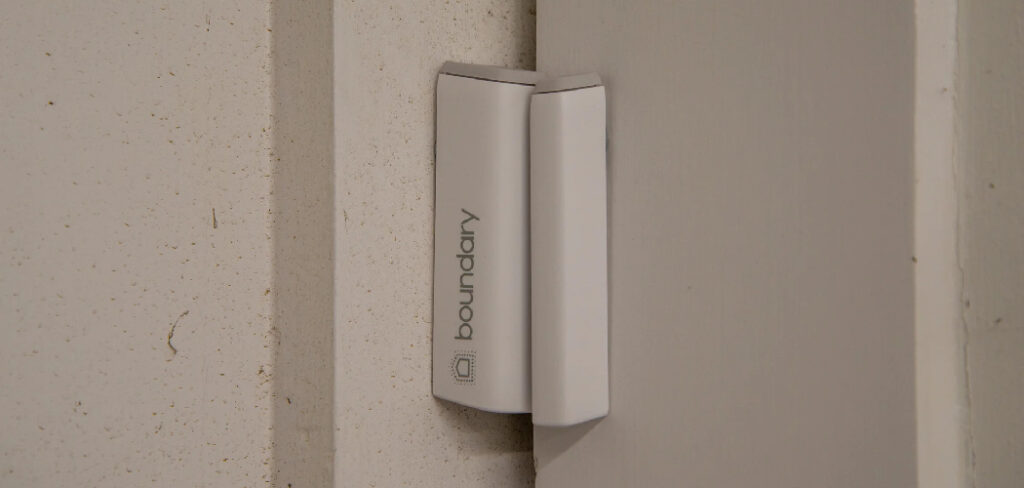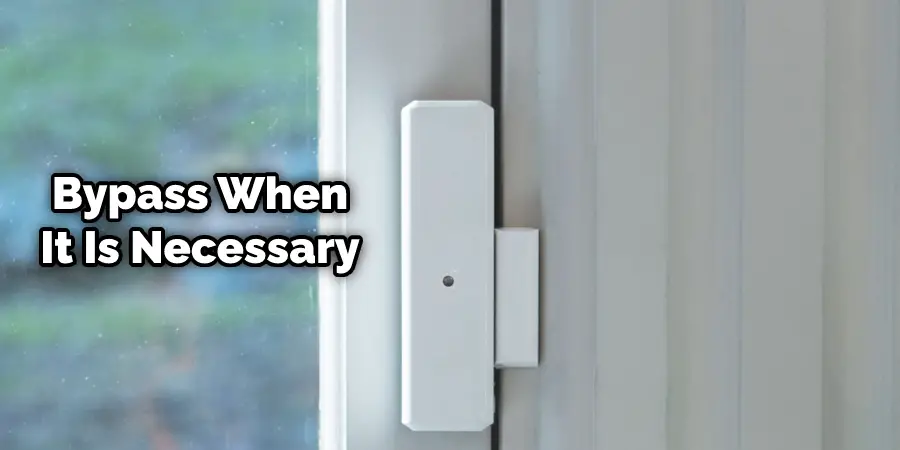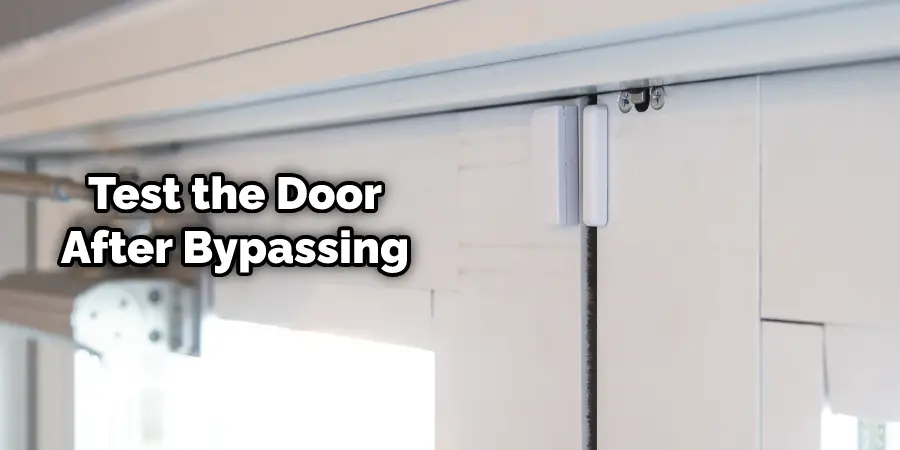If you’ve ever been locked out of your home or office, you know the importance of door sensors. But what if you need to get in without setting off the alarm? Here’s how to bypass alarm door sensor.

What Is an Alarm Door Sensor?
Alarm door sensors are an important part of any security system. They are usually placed on doors and windows, and they work by detecting when the door or window is opened.
When the sensor is triggered, it sends a signal to the alarm system, which sounds like an alarm. Alarm door sensors can be either wired or wireless, and they come in various sizes and shapes.
Some alarm door sensors also have additional features, such as tamper-resistant housing or temperature sensing. However, all alarm door sensors serve the same basic purpose: to protect your home or business from intruders.
Why Should You Want to Bypass the Alarm Door Sensor?
There are several reasons why you might want to bypass the alarm door sensor. It can be a convenient way to enter your home if you forget your key or the code to the alarm system.
Additionally, if the sensor is malfunctioning, it can prevent you from being able to enter your home at all. In some cases, you may also need to disable the sensor to make repairs or maintain the system.
Whatever the reason, bypassing the door sensor is a relatively simple process that can be completed in just a few steps. However, it is important to note that doing so will disable the security benefits of the alarm system. As such, it should only be done when necessary.

How to Bypass Alarm Door Sensor 10 Step-by-Step Guide
Step 1: Remove the Battery
To bypass an alarm door sensor, you will first need to remove the battery from the sensor. This can usually be done by unscrewing the sensor’s back panel. If the sensor is wired, you will need to disconnect it from the power source. You can also turn off the sensor’s power by flipping the circuit breaker. It is important to ensure that the sensor is completely disconnected from power before proceeding.
If the sensor is wireless, you may need to use a tool such as a screwdriver or needle-nose pliers to remove the battery. Once the battery has been removed, wait for at least 30 seconds before proceeding.
Step 2: Cut the Wires
Doors with an alarm system usually have a pair of wires running through the doorframe, connected to the sensor. To bypass the alarm, you’ll need to cut these wires.
To do this, first, locate the wires running through the doorframe. They should be easy to spot, as they’ll be attached to the sensor itself. Once you’ve located the wires, use a pair of wire cutters to snip them.
Step 3: Cover the Sensor
With the wires cut, the sensor will no longer be able to detect when the door is opened. However, it’s still good to cover the sensor to be safe. This can be done with tape or a piece of cloth. Make sure that the sensor is completely covered to prevent any false alarms. Otherwise, the alarm may still be triggered when you try to open the door.
It is also important to note that this method will likely not work if the sensor has a tamper-resistant housing, as it may trigger an alarm if it is tampered with.
Step 4: Magnetic Door Sensor(Optional)
If you have a magnetic door sensor, you can use a strong magnet to bypass the sensor. Place the magnet on the side of the door where the sensor is located. The magnet will trick the sensor into thinking that the door is still closed. This method can be useful if you need to enter the room quickly and without setting off the alarm.
You can also use this method if the sensor is malfunctioning and needs to be temporarily disabled. However, keep in mind that the magnet will need to stay in place until you’re ready to use the door again. Once the magnet is removed, the sensor will resume its normal function.
Step 5: Enter Your Code
If your alarm system requires a code to be entered when unlocking the door, you can bypass the sensor by entering the code immediately after opening the door. This method is best used if you have forgotten your key or code and need to enter quickly without setting off the alarm. Once the code is entered, the sensor will be disabled until the door is closed and opened again.
You can also try this method if the sensor is malfunctioning and preventing you from entering the room. However, keep in mind that the alarm system will no longer be active until the door is opened again. As such, this method should only be used as a last resort.
Step 6: Use an Override Key
Some alarm systems come with an override key that can be used to bypass the sensor. The key is usually inserted into a small slot on the side of the sensor and turned to disable it. If you have access to this key, it can be a quick and easy way to bypass the sensor without causing any damage. However, not all alarm systems come with an override key, so this method may not be an option for everyone.
It is also important to note that using an override key will disable the security system until the sensor is reactivated. You should only use this method if you are comfortable with temporarily disabling your security system.
Step 7: Use a Universal Bypass Tool
If you don’t have an override key, you can purchase a universal bypass tool that works with most alarm systems. These tools work by mimicking the signal sent by the sensor when it is triggered. Simply insert the tool into the slot on the side of the sensor and turn to disable it.
Using a universal bypass tool is quick and easy, but it may not work with all alarm systems. Additionally, these tools can be quite expensive and may not be worth the investment if you only need to use them once.
Step 8: Use a Hacking Device
If you’re feeling tech-savvy, you can try using a hacking device to bypass the sensor. This method works by intercepting the signal sent by the sensor and sending a false signal to the alarm system that makes it think that the door is closed.
However, using a hacking device can be complicated and may require some technical knowledge. Additionally, this method is not recommended as it may be illegal in your area and can damage the alarm system.
Step 9: Contact the Alarm Company
If none of the above methods work or you are uncomfortable bypassing the sensor yourself, you can contact your alarm company for assistance. They may be able to remotely disable the sensor or send someone out to help. Keep in mind that this may incur a service fee, so it should only be used as a last resort.
You can also contact the alarm company for further assistance with troubleshooting the sensor or to get it fixed or replaced if necessary. Remember to always follow their instructions and guidelines to ensure the proper functioning of your alarm system.
Step 10: Reconnect and Test
Once you have successfully bypassed the alarm door sensor and completed your task, it is important to reconnect the sensor and test it. This will ensure that the sensor is functioning properly and your home is once again secure.
However, if you have cut the wires or used a hacking device, you may need to contact a professional technician to properly repair and reconnect the alarm system before testing it. It is also important to note that bypassing the sensor should only be done as a temporary solution and the alarm system should be restored to its full function once the issue has been resolved.
Now that you know how to bypass alarm door sensor, you can enter your home without setting off the alarm. However, it’s important to note that doing so will disable the security benefits of the system. As such, it should only be done when necessary.
How to Bypass a Door Sensor While the System is Armed or Arming
Bypassing a door sensor while the system is armed or arming can be quite difficult, as most security systems have designed their sensors to sense activity only when the system is active or activating. The process usually involves entering the code into the security panel, which will then allow you to enter and exit through certain doors at will.
It’s important to remember that bypassing a door sensor while it’s activated or arming can be dangerous depending on the level of security present in a home. Nevertheless, if done correctly, it can help to ensure that you aren’t locked out after its activation. Knowing what type of system you have can also be helpful for understanding how to bypass its sensors appropriately.
For example, if you have a wireless system, then the process involves entering a code into the security panel which will then allow you to disable any door sensors which are currently active or in the process of arming. The code works by deactivating any alarms connected to the door sensors so that they won’t sound when someone enters or leaves the area.
Another way to bypass a door sensor while it’s armed or arming is through the use of an override switch. These switches come in two types: one that works with a remote control and another that must be manually entered into the security panel. The remote-controlled switches allow you to enter a code from a distance, while the manual switches require you to enter the code into the panel itself.
Bypassing a door sensor while it’s armed or arming can be a tricky process, but knowing what type of system you have and how to use its features is key to ensuring your safety. If done correctly, this process can help you to enter and exit the premises without setting off any alarms.
What Are the Consequences of Bypassing an Alarm Door Sensor?
Bypassing an alarm door sensor is a direct violation of safety procedures and puts both the bypasser and others at risk in an emergency. Alarm door sensors are in place for a reason: to alert those in the area of potential danger.
Bypassing the sensor disables this critical safety feature. In the event of a fire, for example, bypassing the alarm door sensor could mean that people are unaware of the danger and do not have time to evacuate safely.
Bypassing an alarm door sensor is also a security risk, as it can allow unauthorized access to a building or room. This can lead to theft or other crimes. Finally, bypassing an alarm door sensor can result in a fine or other punishment, as it is usually against the law.
How Can You Prevent Someone From Bypassing Your Alarm Door Sensor?
You can do a few things to make it more difficult for someone to bypass your alarm door sensor. One option is to invest in a door sensor that uses an infrared beam. Unfortunately, these beams are harder to see, so it will be more difficult for someone to determine where the sensor is and how to avoid it.
Another option is to install your door sensor at a height where it will be more difficult for someone to reach. Finally, make sure that you test your door sensor regularly to ensure that it is working properly. By taking these simple steps, you can help to deter would-be intruders and protect your home.
Are Alarm Door Sensors Worth It?
The answer to this question really depends on how you plan to use your alarm system. If you are looking for a way to protect your home while away, alarm door sensors can be a great way. They can help to detect when someone is trying to break into your home, and they can also trigger the alarm system to make a loud noise, which will deter the intruder.
However, if you are looking for a way to deter burglars while you are home, then alarm door sensors may not be worth it. This is because most burglars will not try to break into a home when they know an alarm system is in place.
Do You Need Professional Help?
If you are still unsure about how to bypass an alarm door sensor or need assistance with reconnecting and testing your sensor after bypassing it, it is always best to seek professional help. A qualified technician can ensure that your alarm system is functioning properly and provide any necessary repairs or maintenance.

Remember, safety should always be the top priority when it comes to home security systems. It is important to understand how to properly bypass a door sensor for emergency situations, but bypassing it should not become a regular occurrence. Always follow manufacturer instructions and consult a professional if you have any concerns or issues with your alarm system. So don’t hesitate to reach out and get the necessary help to ensure your safety and that of your home. Stay safe!
Frequently Asked Questions:
Q1: Are Alarm Door Sensors Safe?
A1: There is a concern that alarm door sensors are not safe, as they could be used to monitor and track individuals. However, these concerns are unfounded, as the alarm door sensors only collect data when an individual tries to leave the premises without authorization.
Q2: What Is the Best Way to Bypass Alarm Door Sensor?
A2: There are a few different ways to bypass the alarm door sensor. One way is to use a magnet. Another way is to use a foil. The best way to bypass the alarm door sensor is to use a foil because it is the easiest way.
Q3: How Long Does Alarm Door Sensors Battery Last?
A3: The battery life of an alarm door sensor can last anywhere from six to twelve months. If you find that your alarm door sensor battery is running low or has already died, you can bypass the sensor by temporarily removing the battery. However, it’s important to replace the battery as soon as possible to ensure optimal protection for your home.
Q4: Can You Install an Alarm Door Sensor Yourself?
A4: Yes, most alarm door sensors can be installed by the homeowners themselves. However, if you are not comfortable with DIY projects or have a more complex security system, it may be best to hire a professional for installation to ensure the proper placement and functionality of the sensor. Overall, it is recommended to consult with a security expert for the best and safest installation method.

Conclusion
Bypassing alarm door sensors is a serious crime that can lead to time in prison. If you are ever faced with this situation, it is best to contact the police and leave the scene. Thanks for reading our post about how to bypass alarm door sensor. We hope that you found it informative and helpful. Remember to always follow safety procedures and use caution when dealing with alarm systems. Stay safe!
You can also read it: How to Block Night Vision Cameras

1 thought on “How to Bypass Alarm Door Sensor”